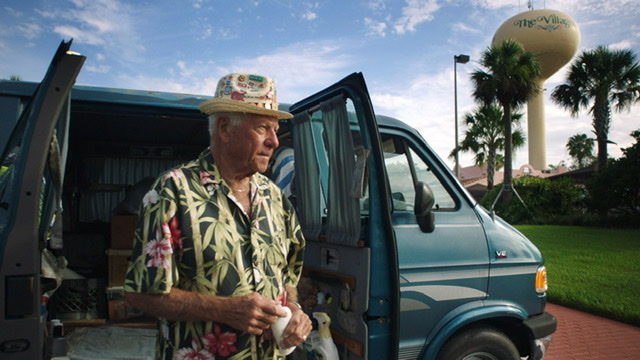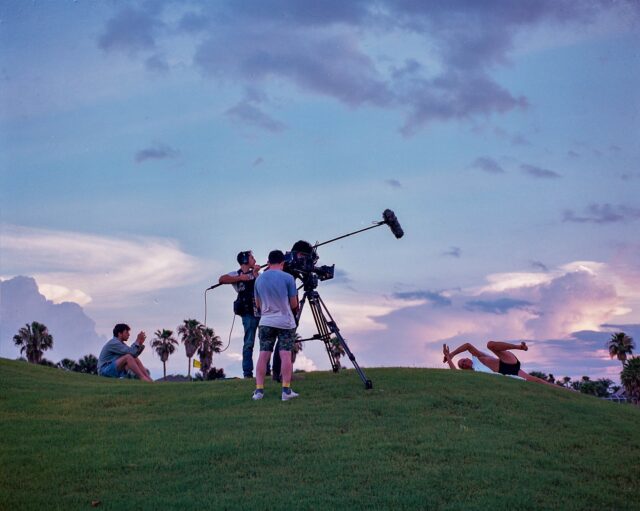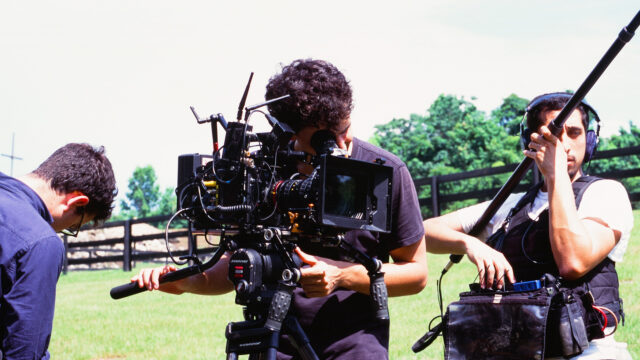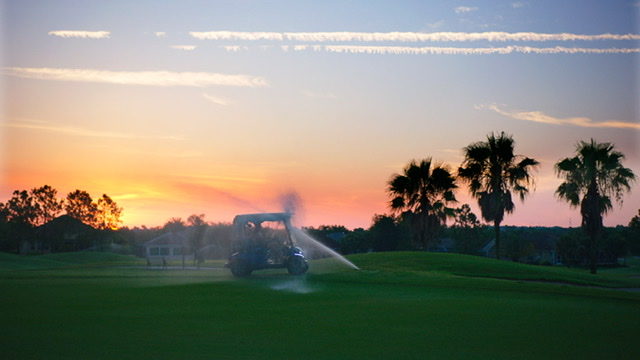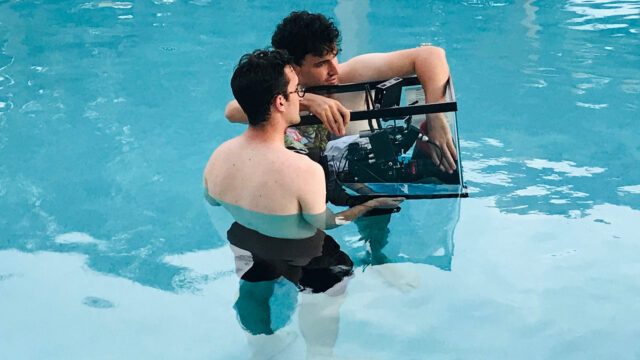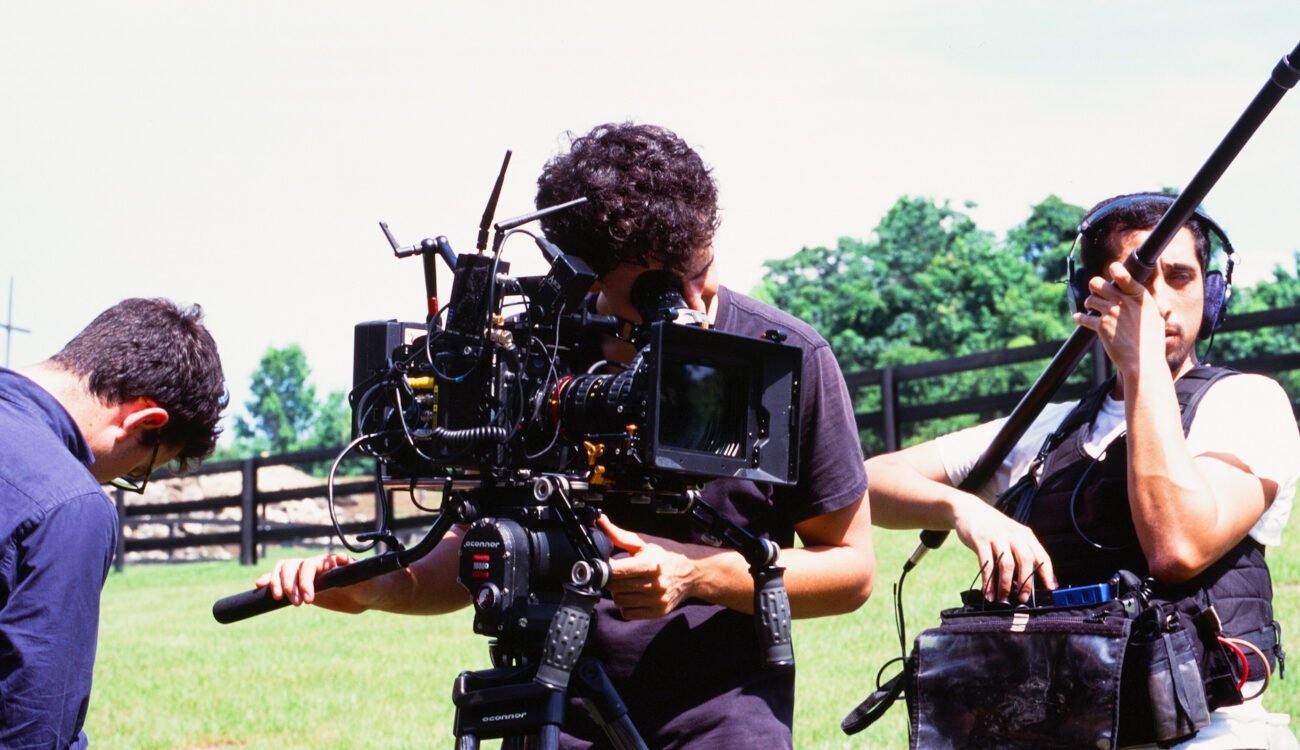
Lance Oppenheim set out to tell the world there was more to the lives of folks living at The Villages than golf carts, bridge games, and all the world comes to expect from a “Disneyland for Retirees.” Together with friend and DP David Bolen, Oppenheim creates a vivid and intimate documentary of life in later years, following characters with aspirations of adventure, romance, and self-discovery. Read on to learn how Bolen decided to capture the film at 4:3 and how his collaboration with Oppenheim elevated the vibrant images of their firs feature together: Some Kind of Heaven.
Name: David Bolen
Film: Some Kind of Heaven (dir. Lance Oppenheim)
Competition Category: NEXT
Camera Body: Alexa Mini
Glass: Angenieux Optimo Style Zooms (16-40mm, 30-76mm) Fujinon 19-90mm, Zeiss Superspeed 35mm
cinema5D: What was your path into cinematography? Did you always pursue the camera department?
DB: I was very fortunate to come from a family that was super supportive of my filmmaking. My parents gave me a camera when I was 6 years old, and I’ve been making movies ever since. I decided to go to film school, because I wasn’t really aware that there was another way to get into the business. I started at the University of British Columbia, and then transferred to USC’s School of Cinematic Arts.
I always thought I’d be a director, but film school was a time of discovering who I was as an artist. I’ve always been obsessed with light and texture, and I think I began to discover that I was more interested in the visual poetry of film. In film school, I shot for as many people as I could and tried to get my name out there. As time went on, I began spending way more time on set and way less time in class. I was super fortunate that by the time I graduated, I was able to at least scrape by shooting documentaries and branded content. Back then, the projects weren’t great, but I was happy to be doing what I loved.
cinema5D: What other cinematographers have inspired you?
Sean Bobbitt and Bradford Young are two cinematographers, who have had a big influence on my work. Sean Bobbitt shot films including Place Beyond the Pines, Hunger and Shame, and originally came from documentary filmmaking. I’ve always been inspired by his handheld work, and his naturalistic approach to coverage. Sometimes things feel sloppy, shaky, or out of focus, but it actually gives his images a sense of urgency and authenticity that brings me closer to the story. There are times when I think DPs are too precious with their images, and it actually distracts you from the storytelling.
Bradford Young is another DP I love, and he’s shot many of my favorite films, including Arrival, Ain’t Them Bodies Saints and Pariah. His lighting and compositions create such a distinctive mood and feel. As a DP, I’ve always been attracted to darkness, and his work helped me to understand the power of underexposing an image. I think the texture found in the lower end of the shadows can be so beautiful when done right.
cinema5D: What’s your strategy in being the best DP you can be? How do you like to run the camera department
Nowadays, I primarily work on narrative television shows and films, which can be quite isolating at times. There are so many people on set and so many rules and regulations. It can often be frustrating. For this reason, I get very excited to return to more intimate documentary projects where it’s just a few friends giving it their all and trying to make a movie together. For documentary, it’s incredibly important to find an intimate group of people, who trust each other completely and are willing to do anything for the project. On Some Kind of Heaven, it was typically just me, Lance, our sound guy Richard Carlos, and our producers Christian Vasquez and Mel Oppenheim. We all treated the film as a passion project and we all believed in Lance’s vision.
With documentaries, you have to be reactive to your characters, so some days are extremely long, and sometimes you’re waking up to shoot in the middle of the night. I remember one evening where Lance woke us up at 3am to film one our characters in a hurricane. I’ve been on documentary sets where crews just treat it like a job that ends after 12 hours, and it always frustrated because you can miss important scenes that way.
It’s also important for the crew to be close, because you want to create a comfortable space for your subjects when filming. Being on camera is scary for anyone, but when our subjects saw how close we were, I think it made them feel safe to share their vulnerabilities. It’s really important to capture real moments with people, and it’s not possible if the energy with the crew is off.
cinema5D: How did you become attached to Some Kind of Heaven?
Lance and I have been making movies together for over 7 years now. We actually first met when he was still in high school, and I was at USC for film school. I was blown away by him at the time because he was only 16 years old. His work had the maturity of a seasoned filmmaker. We started working on short documentaries together, and eventually we made a New York Times Op-Doc called Long Term Parking. When he approached me about shooting Some Kind of Heaven, deciding to shoot it was a no-brainer.
cinema5D: Seven years! That’s a pretty long partnership. Do you have any advice for other directors on how to cultivate a really successful relationship with their DPs?
This is a really interesting question, and something I’m always thinking about. On an emotional level, a lot of artists are sensitive people. It can be scary to put your ideas on the table because you feel they may be rejected. Strong directors creates a safe place for their DP to experiment and push boundaries, where they feel free to try things even if they don’t work. Lance is particularly amazing at this. He never wants to play things safe and constantly encourages me to try weird, experimental approaches with the image. Sometimes we push it too far, or go off track, but when we get it right, it can be really magical. Shooting with him is something I always look forward to, because I know it will be a chance to do things I’ve never done before.
cinema5D: So what about Some Kind of Heaven made you excited to tell the story?
First and foremost, I was excited to collaborate with Lance on a feature-length project. Leading up to this point, we had only done shorts together, so I was eager to tackle a long-form project, where we could develop a more mature and unique visual language. Beyond this, I was fascinated by the subject matter Lance wanted to explore. He told me he wanted to make a film about The Villages, Florida, which is one of the largest retirement communities in the world. It’s a place where retirees go to live our their final chapter of the American Dream, a utopian community designed to simulate the “good old days” when they were children.
Lance wanted to dig deeper and tell the story of a few characters trying to find a new lease on life. We wanted to explore themes of death, aging, time, and purpose. I was fascinated by the place, because on the outside it seems like a dream world, but as you move deeper into the individual homes, there’s a darkness and loneliness to explore. Everyone who lives in the Villages is expected to act happy, but inside they are dealing existential crises. The contrast of these two ideas really intrigued me, and I was excited to pursue this contrast in the visual language of the film.
cinema5D: So why did you pair this array of glass with Alexa Mini to capture that visual language?
In my ideal world, we would have this project on 16mm film, but because of the pure amount of footage we intended to capture, it would have been nearly impossible to pull off. To me, the next best thing is the Alexa Mini. It captures beautiful, organic images, and with the right color grade, I think it can look quite filmic. The small size also made it ideal for vérité filmmaking. It was important that we kept a low profile, so we could capture intimate, fly on the wall moments. We primarily used a set of Angenieux Optimo Style Zoom Lenses, a 16-40mm and 30-76mm. They are lightweight and small, but also gave us the flexibility to quickly change focal lengths. People often think zoom lenses aren’t as good as primes, but I love the look of the Angenieuxs and also use them on narrative projects. They have a really filmic look to them, and vignette slightly on the edges, which I love. We also used a long Fujinon Servo zoom for certain stylized slow zoom shots. Finally, we used a Zeiss Superspeed 35mm for night sequences when there wasn’t a lot of light available. It’s amazing the exposure you can get with the Alexa Mini at 1600 ISO and a Superspeed wide open.
cinema5D: Did you watch any films with Lance or pull reference images during pre-pro?
In pre-production, Lance I talked a lot about the feel of the film. Primarily, we looked at photographs from Larry Sulton’s “Pictures from Home.” It’s a series documenting Larry’s parents as they settle down for retirement in a Palm Springs home. His unique, ultra-wide framing creates a really beautiful sense of loneliness and isolation.
In terms of movies, we became obsessed with a film called “Safe” by Todd Haynes. Nicole Kidman plays a housewife, who believes she has an environmental sickness caused by air pollution. The cinematography is quiet and thoughtful, and it creates a disturbing portrait of someone locking themselves inside. The framing and color palette tells so much of the story; it was a great reference for how we’d film our characters when inside their homes.
cinema5D: How about during principle photography? Anything unique that came from your collaboration with Lance on this film in particular?
With documentary, Lance and I have a very organic approach. Both the look of the film and the characters we would follow were something that developed and evolved over time, until it become something really concrete. On our first few days of filming, we did things totally wrong.
We started with a 16×9 aspect ratio, and shot mostly handheld. I remember getting back to the Airbnb and feeling sick to my stomach about the footage. It all just felt messy and unmotivated, and not at all what was right for the project. Then I started playing around in Davinci Resolve, adding 4:3 bars to the footage. All of a sudden, the frames began to make sense. The Villages community is all about recreating the good-old days, where retirees can live in a nostalgic fantasyland. 4:3 helped to mimic this feeling, creating a style that seemed similar to an old movie they would have watched as children. From there, we decided to cut handheld all together and shoot the entire film on tripod. Shooting vérité in this style was really difficult at first, but it forced us to create wider compositions that felt more striking and less random. We tried to make every frame feel like a composed photograph where our characters could move through the world.
cinema5D: How was the set culture?
At this point, Lance feels like a brother to me. He’s not only one of my closest collaborators, but he’s one of my closest friends. We are constantly pushing each other to capture weirder, more surreal footage. He’s extremely collaborative and invites everyone on set into the process. Between locations changes we’d all discuss different scenes, or characters and how we could make it better. Our sound guy Richard Carlos is an amazing director in his own right, and often came up with some of the best ideas for scenes. This kind of environment on set is really rare in my opinion. So many directors are fearful of looking indecisive, but Lance favors honestly and transparency. We all feel welcome to chime in, and that ultimately leads to a better film.
cinema5D: Was it intimidating to have Aronofsky as a producer? Or was it empowering?
Having Aronofsky onboard as a producer was fantastic. Lance and I both love his movies, and his surrealist style of filmmaking. Darren provided amazing notes throughout the process and pushed us to make a better film. There was a point in the edit where we thought we were pretty close to finishing, and he gave us a wake up call that we needed to capture more footage and push the film into a better place. On our final trip, we got some of our best footage, and it honestly made the film so much stronger.
cinema5D: Any new tech or mode of operation on this shoot?
One interesting thing we got to do on this project, was shoot 4:3 Open Gate on the Alexa Mini Sensor. Typically, Open Gate with the Alexa is reserved for Anamorphic projects, but we instead used it with spherical lenses since our final aspect ratio was 4:3. This format allowed us to use the full range of the sensor, and gave us the ability to capture a super wide field of view. It was fantastic for capturing the sprawling landscapes of the Villages, and we used it to to frame our characters in really interesting ways. I love use wide angles to capture faces, as I think it leads to a much more interesting and intimate portrait. Telephoto lenses have always felt too distant to me.
cinema5D: Any go-to filtration in your kit? Any that you used on Some Kind of Heaven?
I’m a bit of a filtration junky (sometimes to a fault), and on this project I used one of my favorite filters: a Tiffen Soft FX 2. I first got into this filtration after reading about Reed Morano’s obsession with it, and for some reason the level 2 intensity has always appealed to me. It softens the image in a dynamic way, without blooming the highlights too intensely. Generally, it helped add to the dream-like surreal feel of the film.
cinema5D: Were you able to light the residences? What was your strategy there?
Lighting documentaries is a challenge because you want to leave a small footprint but still make the footage look great. For the most part, we used natural light and practicals available at the locations to pull off our look. We’d typically shoot exterior scenes at sunrise or sunset, and then go inside during the middle of the day when the light was too harsh. I’d keep a small kit of my own battery-powered Quasars and a few Astera RGB tubes for whenever it was too dark to get exposure. Lastly, we used an Arri Skypanel 60C for some experimental drug trip scenes, which were sadly cut from the final film, but the effect was really cool. I love documentaries because it forces you to find the beauty in natural light. Personally, I think putting someone next to a single window is one of the most wonderful ways to light a scene.
cinema5D: Agreed! What was your involvement in post? Did you have a say on the color?
Lance is a great collaborator and always includes the entire team in post. We shot our film over the course of four trips, but in-between, Lance was constantly sending me cuts of different scenes to get my temperature on things.
During our first trip, I experimented with the footage and made a LUT, which kind of had the feel of an old-faded photograph. It was applied to transcodes for the edit, and helped to get everyone on board to the general look we were trying to create. When the film finally pictured-locked, we were lucky enough to work with colorist Damien Van Der Cruyssen at the Mill NY, who’s recent credits include Uncut Gems, Waves and The Last Black Man in San Francisco. We saw his work on Waves, and knew he would be a good fit for the Florida color palette.
Once again we referenced Larry Sulton’s “Pictures from Home.“ Damien really helped us create a consistent palette and pushed the Alexa footage into really cinematic territory. He’s truly a master of making digital look like film.
cinema5D: What’s your take on where cinematography is heading? Have you been frustrated at all with the obsession over advancing resolutions?
Technology is fantastic, but I think today’s current emphasis on resolution has gone a bit overboard. I’m currently shooting a Netflix project and have been frustrated that the Alexa Mini isn’t approved because it doesn’t shoot true 4k.
cinema5D: What is your advice to filmmakers looking to advance their careers?
I think the best advice I can give is to choose projects that really speak to you on an emotional level. It’s easy to think the best project is the one with the biggest budget or the flashiest production company behind it. I’ve done those projects before, and money can only get you so far. Your best work will only come if you truly connect with the material. With Some Kind of Heaven, I connected so deeply with our characters and what they were going through. This connection informed everything. It guided me with where to put the camera and how to capture the images. The work is much stronger because of it.
Some Kind of Heaven was produced by The New York Times, the LA Media Fund, and Darren Aronofsky. At this time, the documentary is still pursuing distribution.
